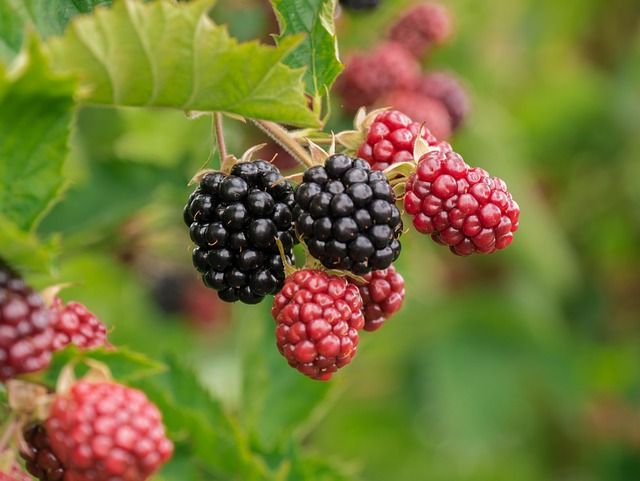
VERSIÓN ESPAÑOL:
¿Cómo va la gente de Blurt?
Les aúllo el chisme por el que seguro vienen a leer a mi cueva de meditación:
La mora es el fruto de varias especies de arbustos pertenecientes al género Rubus, dentro de la familia de las rosáceas. Este fruto se caracteriza por su color oscuro, que varía del rojo intenso al negro brillante cuando está maduro. Su sabor puede ser dulce a ligeramente ácido, dependiendo de la variedad y el grado de maduración.
Crece en climas templados y se desarrolla sobre arbustos espinosos de tallos arqueados o trepadores. Las moras están formadas por un conjunto de drupas pequeñas y agrupadas, cada una de las cuales contiene una semilla diminuta. Su temporada de recolección suele abarcar los meses cálidos, desde finales de primavera hasta el otoño.

Desde el punto de vista nutricional, las moras son una fuente rica de vitaminas, minerales y antioxidantes. Destacan por su alto contenido en vitamina C, vitamina K, fibra dietética y compuestos fenólicos, que se asocian a propiedades antioxidantes y antiinflamatorias. Estos componentes ayudan a fortalecer el sistema inmunológico, favorecen la digestión y contribuyen a la salud cardiovascular.
En la cocina, las moras se consumen frescas o se utilizan en la preparación de mermeladas, jaleas, postres, batidos, salsas y bebidas. También se pueden deshidratar o utilizar como ingrediente en repostería y productos lácteos. Su sabor y versatilidad las convierten en un alimento apreciado tanto en preparaciones dulces como en combinaciones agrícolas.
Además de sus usos culinarios, las moras tienen aplicaciones en la medicina tradicional. Se les atribuyen propiedades astringentes, digestivas y depurativas. Las hojas del arbusto, preparadas en infusión, se han utilizado para aliviar molestias gastrointestinales y dolores de garganta.

El cultivo de moras requiere suelos bien drenados y una exposición solar moderada. Los arbustos necesitan una poda regular para estimular la producción de frutos y controlar el crecimiento de las ramas. Por su facilidad de cultivo y alto rendimiento, las moras son populares tanto en huertos domésticos como en la producción comercial a gran escala.
Las moras ofrecen una amplia gama de beneficios para la salud debido a su rica composición nutricional. Son una fuente destacada de antioxidantes, como polifenoles, antocianinas y vitamina C, que ayudan a combatir el estrés oxidativo y a proteger las células del daño causado por los radicales libres. Este efecto antioxidante se asocia a un menor riesgo de enfermedades crónicas, como las cardiovasculares, la diabetes tipo 2 y ciertos tipos de cáncer.
El alto contenido de fibra de las moras favorece el tránsito intestinal, previene el estreñimiento y contribuye a la salud digestiva. La fibra también juega un papel importante en la regulación de los niveles de glucosa en sangre, lo que puede ser beneficioso para las personas con diabetes o en riesgo de desarrollarla. Además, ayuda a mantener la saciedad durante más tiempo, lo que puede ser útil para el control del peso corporal.

Las moras contienen vitamina K, esencial para la coagulación sanguínea y la salud de los huesos. También aportan manganeso, un mineral que participa en el metabolismo energético y la formación de tejidos conectivos. La combinación de estos nutrientes ayuda a fortalecer los huesos, prevenir fracturas y mantener una estructura ósea saludable.
El consumo regular de moras puede mejorar la salud cardiovascular. Los antioxidantes y compuestos antiinflamatorios que contienen ayudan a disminuir la presión arterial, mejorar la circulación sanguínea y disminuir los niveles de colesterol LDL (conocido como colesterol “malo”), mientras que pueden aumentar los niveles de colesterol HDL (colesterol “bueno”). Estos efectos favorecen la prevención de enfermedades como la aterosclerosis, los accidentes cerebrovasculares y los ataques cardíacos.
En el campo neurológico, los compuestos bioactivos presentes en las moras pueden tener un efecto positivo en la salud cerebral. Estudios sugieren que comer frutas ricas en antocianinas podría mejorar la memoria, la función cognitiva y la capacidad de aprendizaje, así como ayudar a retrasar el deterioro cognitivo asociado al envejecimiento.
Otro beneficio destacable de las moras es su potencial para fortalecer el sistema inmunológico. Gracias a su contenido en vitamina C, estas frutas estimulan la producción de glóbulos blancos, mejoran la respuesta del cuerpo a las infecciones y aceleran la cicatrización de heridas. También tienen propiedades antimicrobianas que pueden ayudar a combatir bacterias y otros patógenos.
Además de sus beneficios físicos, las moras tienen un impacto positivo en la salud de la piel. Los antioxidantes ayudan a proteger la piel del daño UV y del envejecimiento prematuro, mientras que las vitaminas y los minerales promueven la regeneración celular, dando una apariencia más saludable y brillante.
Ya los leo más tarde.
Chau.
ENGLISH VERSION:
How's it going, Blurt folks?
I am telling you the gossip that you are surely coming to read in my meditation cave:
The blackberry is the fruit of several species of shrubs belonging to the Rubus genus, within the Rosaceae family. This fruit is characterized by its dark color, which varies from deep red to shiny black when ripe. Its flavor can be sweet to slightly acidic, depending on the variety and degree of ripeness.
It grows in temperate climates and develops on thorny shrubs with arching or climbing stems. Blackberries are made up of a set of small, grouped drupes, each of which contains a tiny seed. Its harvest season usually covers the warm months, from late spring to autumn.

From a nutritional point of view, blackberries are a rich source of vitamins, minerals and antioxidants. They stand out for their high content of vitamin C, vitamin K, dietary fiber and phenolic compounds, which are associated with antioxidant and anti-inflammatory properties. These components help strengthen the immune system, promote digestion and contribute to cardiovascular health.
In the kitchen, blackberries are consumed fresh or used in the preparation of jams, jellies, desserts, smoothies, sauces and drinks. They can also be dehydrated or used as an ingredient in pastries and dairy products. Their flavor and versatility make them a valued food both in sweet preparations and in agricultural combinations.
In addition to their culinary uses, blackberries have applications in traditional medicine. They are attributed with astringent, digestive and purifying properties. The leaves of the bush, prepared as an infusion, have been used to relieve gastrointestinal discomfort and sore throats.

Growing blackberries requires well-drained soil and moderate sun exposure. The bushes need regular pruning to stimulate fruit production and control branch growth. Because of their ease of cultivation and high yield, blackberries are popular both in home gardens and in large-scale commercial production.
Blackberries offer a wide range of health benefits due to their rich nutritional composition. They are an outstanding source of antioxidants, such as polyphenols, anthocyanins, and vitamin C, which help fight oxidative stress and protect cells from damage caused by free radicals. This antioxidant effect is associated with a lower risk of chronic diseases, such as cardiovascular diseases, type 2 diabetes, and certain types of cancer.
The high fiber content of blackberries promotes intestinal transit, prevents constipation, and contributes to digestive health. Fiber also plays an important role in regulating blood glucose levels, which can be beneficial for people with diabetes or at risk of developing it. In addition, it helps maintain satiety for longer, which can be useful for body weight control.

Blackberries contain vitamin K, which is essential for blood clotting and bone health. They also provide manganese, a mineral involved in energy metabolism and the formation of connective tissues. The combination of these nutrients helps strengthen bones, prevent fractures, and maintain a healthy bone structure.
Regular consumption of blackberries can improve cardiovascular health. The antioxidants and anti-inflammatory compounds they contain help lower blood pressure, improve blood circulation, and decrease levels of LDL cholesterol (known as “bad” cholesterol), while they can increase levels of HDL cholesterol (“good” cholesterol). These effects favor the prevention of diseases such as atherosclerosis, strokes, and heart attacks.
In the neurological field, the bioactive compounds present in blackberries may have a positive effect on brain health. Studies suggest that eating fruits rich in anthocyanins could improve memory, cognitive function, and learning ability, as well as help delay cognitive decline associated with aging.
Another notable benefit of blackberries is their potential to strengthen the immune system. Thanks to their vitamin C content, these fruits stimulate the production of white blood cells, improve the body's response to infections, and speed up wound healing. They also have antimicrobial properties that can help fight bacteria and other pathogens.
In addition to their physical benefits, blackberries have a positive impact on skin health. Antioxidants help protect the skin from UV damage and premature aging, while vitamins and minerals promote cell regeneration, giving a healthier, brighter appearance.
